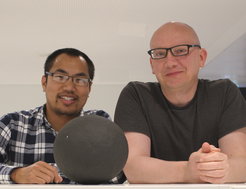Cosmic namesakes
The International Astronomical Union has honored MPS scientists Guneshwar Thangjam and Thomas Platz by naming two asteroids after them.
Two asteroids are now referred to by the names of scientists from the Max Planck Institute for Solar System Research (MPS) in Germany. As announced by the International Astronomical Union (IAU), the two asteroids are now called (11806) Thangjam and (11808) Platz. With this decision, the IAU honors Dr. Guneshwar Thangjam and Dr. Thomas Platz for their contributions to NASA’s asteroid mission Dawn.
As early as 36 years ago, the two asteroids were discovered at the Siding Spring Observatory in Australia - and listed first under the designations 1981 EF14 and 1981 EM17. These rather sober names follow the typical provisional nomenclature for newly found asteroids: while the first number indicates the year of discovery, the second part of the name is an abbreviation which identifies the order in which the asteroids were first spotted in the corresponding year.

In the following years, observation campaigns sporadically focused their attention on these bodies. Some of their basic properties, as well as their exact orbital parameters, are now known. Only then the IAU allocates permanent numbers to asteroids. Later on also a name is chosen – as in the two current cases. Frequently these names are selected to honor researchers or celebrities; the preceding number contains information on the order in which the orbital parameters were determined with certainty.
Like most representatives of their kind (11806) Thangjam and (11808) Platz circle the Sun within the so-called asteroid belt between the orbits of Mars and Jupiter. While asteroid Thangjam needs 3.38 years for one orbit, asteroid Platz requires 4.08 years. Both bodies measure a maximum of about 30 kilometers in diameter, whereas asteroid Thangjam can be seen slightly brighter in the night sky than asteroid Platz.
The available data is not significantly more extensive than that. This is also typical of most of the approximately 600,000 known inhabitants of the asteroid belt. Exceptions are the asteroid Vesta and the dwarf planet Ceres, which were and are the targets of the NASA mission Dawn from 2011 to 2013 and since 2015, respectively. The camera system on board the space probe, which was developed and built at the MPS, was able to capture a total of 90,000 images of both bodies from close proximity. Analyzing these images is the research field of Dr. Guneshwar Thangjam and Dr. Thomas Platz.
Thomas Platz has been a member of the Dawn team for two years. His main research interest is the diverse geology of dwarf planet Ceres. In his analyzes, the researcher was able to reconstruct the evolution of the Occator crater in Ceres’ northern hemisphere in detail. The distribution of bright, salt-bearing material in the crater’s interior as well as the age of the various surfaces indicate that the Occator was once the site of cryovolcanic activity: until recently, a brine must have escaped there from within. In his search for water, Platz also focuses on Ceres’ poles. There he discovered craters, in whose permanent shadow frozen water has survived.
Thomas Platz studied geology and palaeontology at the University of Greifswald in Germany and received his doctorate from the Massey University in New Zealand with a thesis on volcanism. Only then did he turn to the geology of more distant bodies in our solar system. After research periods at the Freie Universität Berlin in Germany and the Planetary Science Institute in the USA, Platz has been working at the MPS since 2015.
Dr. Guneshwar Thangjam is from Manipur, an Indian state in the very northeast of the country close to Myanmar. He has been working at the MPS since 2012. His doctoral thesis, which he completed in 2015, was based on Framing Camera data from asteroid Vesta. Since Dawn’s Framing Camera is equipped with seven color filters, the light reflected by Vesta into space can be split into individual wavelength ranges. These contain information on the mineralogical composition of the surface - and thus information that would be hidden from the naked eye. With his analyzes, Thangjam helped to decipher the history and evolution of Vesta. For example, the course of the impacts that tore the giant crater at the southern pole of the Vesta was reconstructed and he could prove that the mineral olivine found on Vesta was introduced by external impacts. Since the arrival of the space probe Dawn at dwarf planet Ceres, Thangjam has been working on geologic studies of Ceres and also contributing to the search for signs of frozen water and brines from its interior.
Guneshwar Thangjam studied physics, chemistry, and mathematics at the Guru Nanak Khalsa College, Yamuna Nagar in India. He received a Master’s Degree of Science in Geology from the Bundelkhand University, Jhansi in India. Before starting his doctorate at MPS and at the University of Clausthal, he worked as a researcher at the Indian Space Research Organisation (ISRO), where he analyzed data from the Indian moon mission Chandrayaan-1.

In the coming months, together with colleagues from the MPS both researchers want to take a closer look at "their" asteroids - not as a research project, but rather from private curiosity. They use a telescope in Australia, which can be controlled over the internet. First images of asteroid (11808) Platz have already been recorded in this way. Asteroid (11806) Thangjam will not come into the telescopes’ field of view before December - leaving a few months of anticipation until the encounter with a cosmic namesake.

